Java_Mybatis
Mybatis是一款优秀的持久层框架,用户简化JDBC(使用Java语言操作关系型数据库的一套API)开发
使用Mybatis查询所有用户数据:
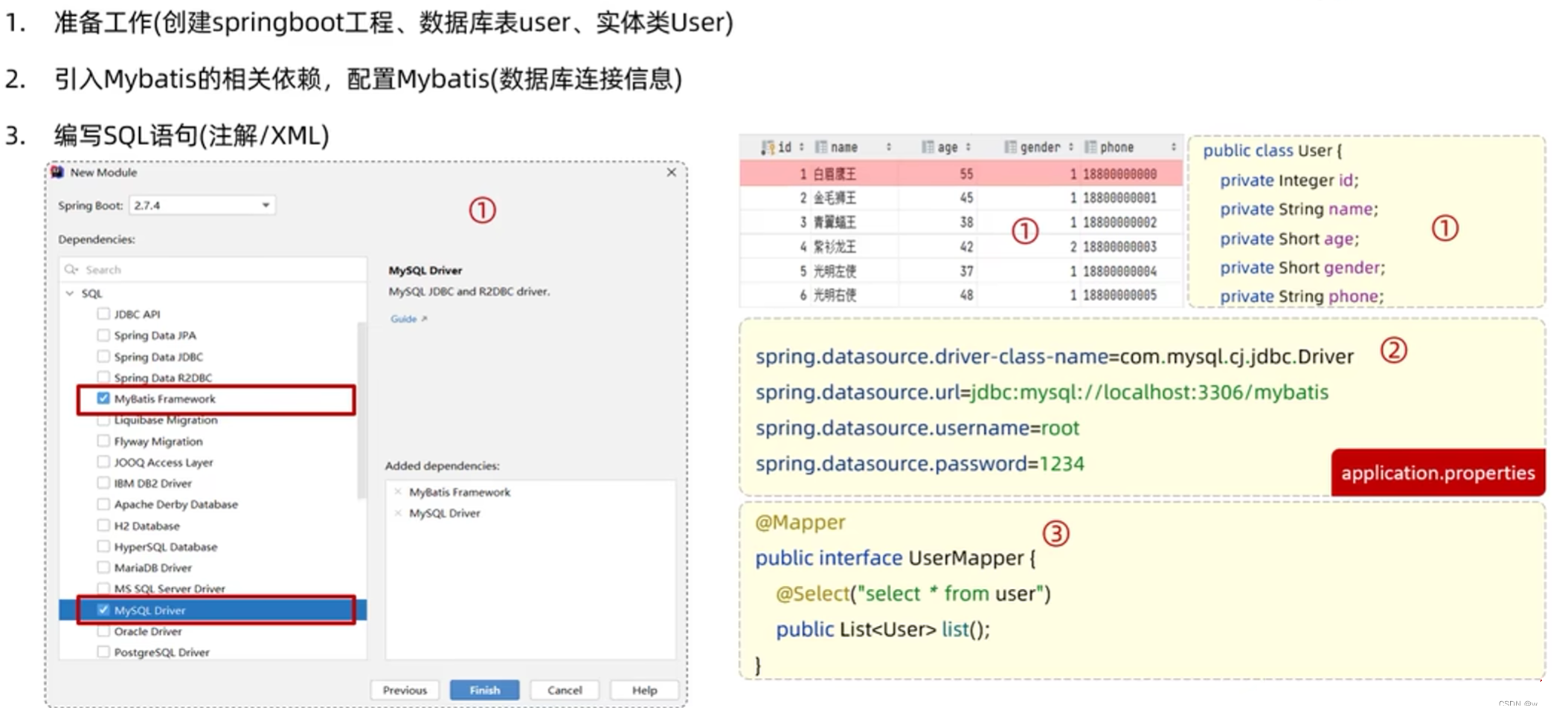
代码演示:
UserMapper:
@Mapper //被调用时会通过动态代理自动创建实体类,并放入IOC容器中
public interface UserMapper {@Select("select * " +"from user")public List<User> list();}单元测试中使用:
@SpringBootTest
class SpringbootMybatisQuickstartApplicationTests {@Autowiredpublic UserMapper userMapper;@Testpublic void contextLoads() {List<User> list = userMapper.list();list.stream().forEach(user -> System.out.println(user));}}JDBC

JDBC与Mybatis相比:
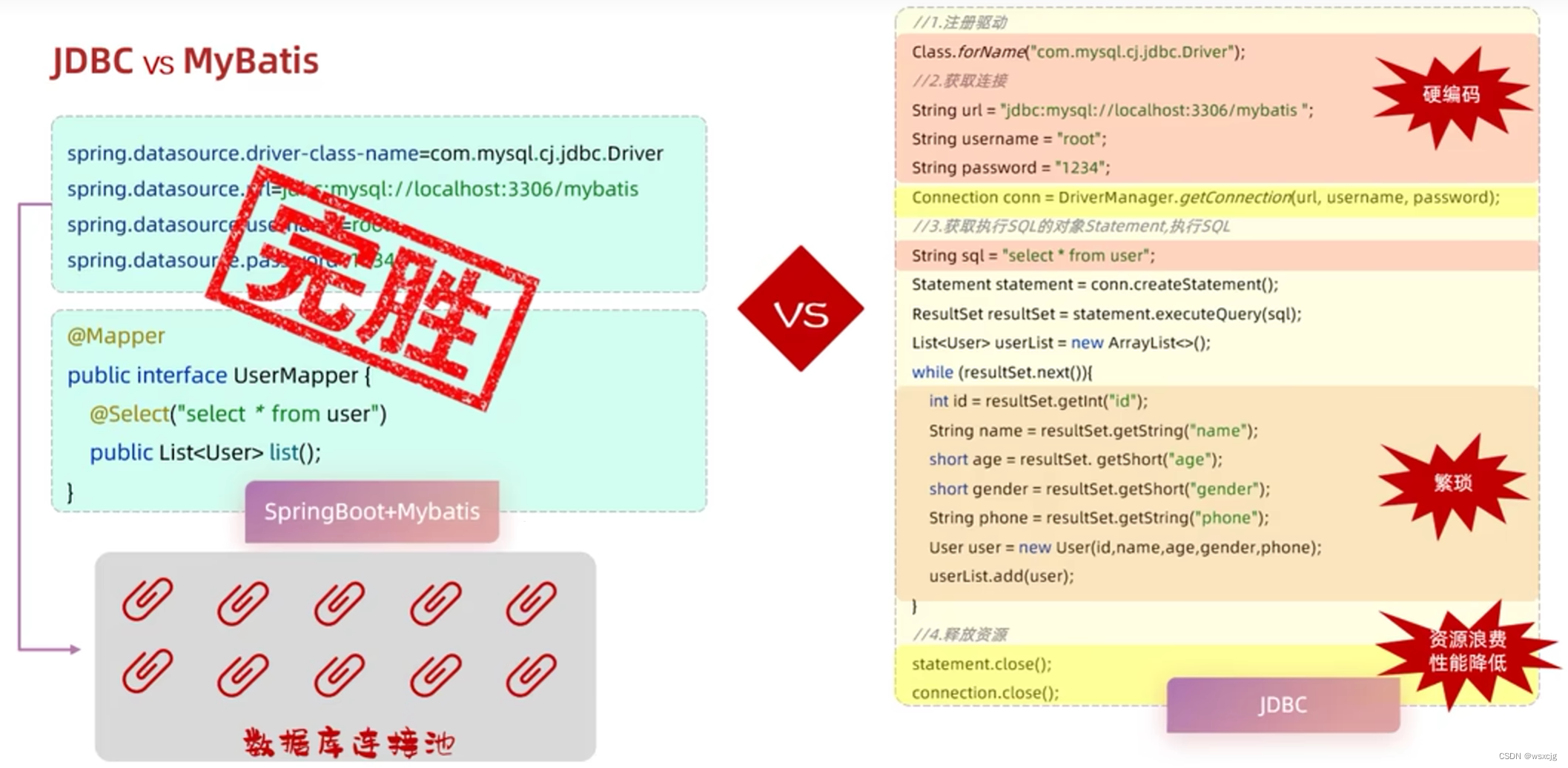
数据库连接池:
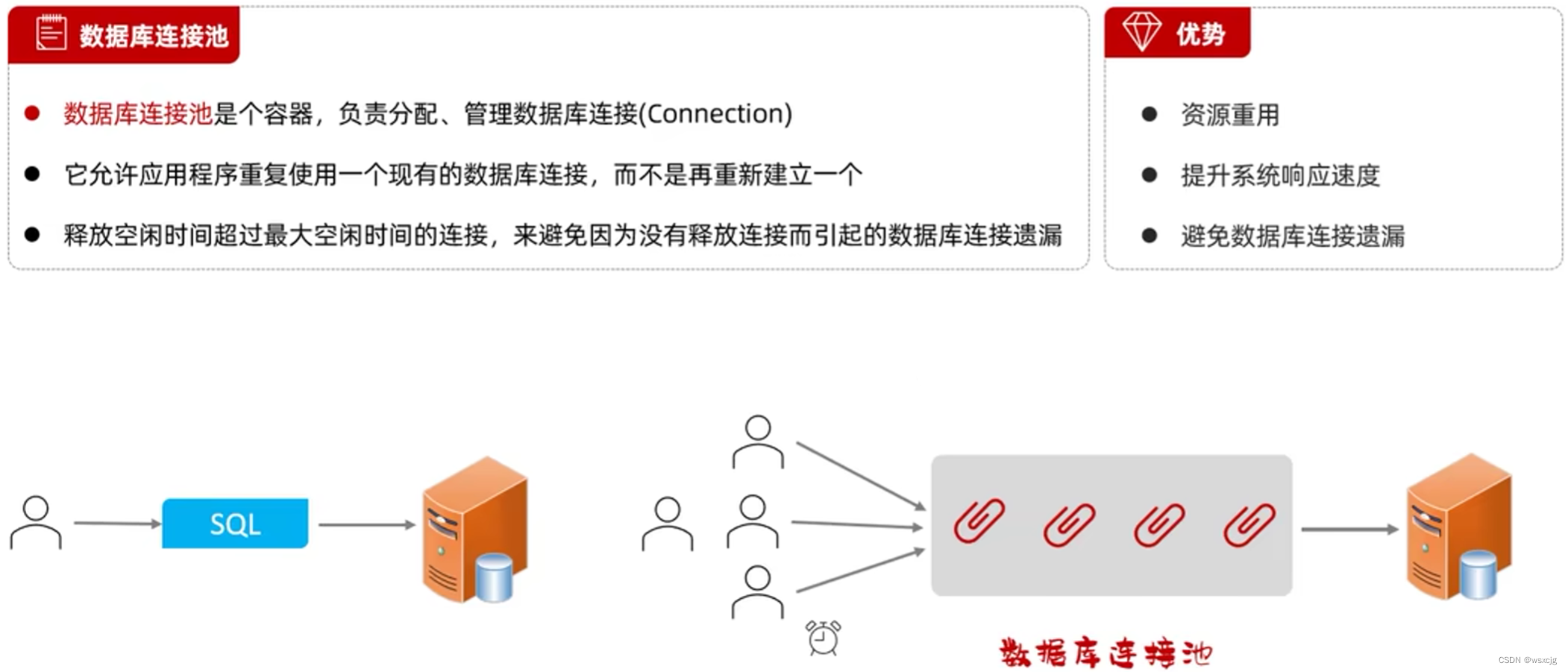
总结:

lombok:
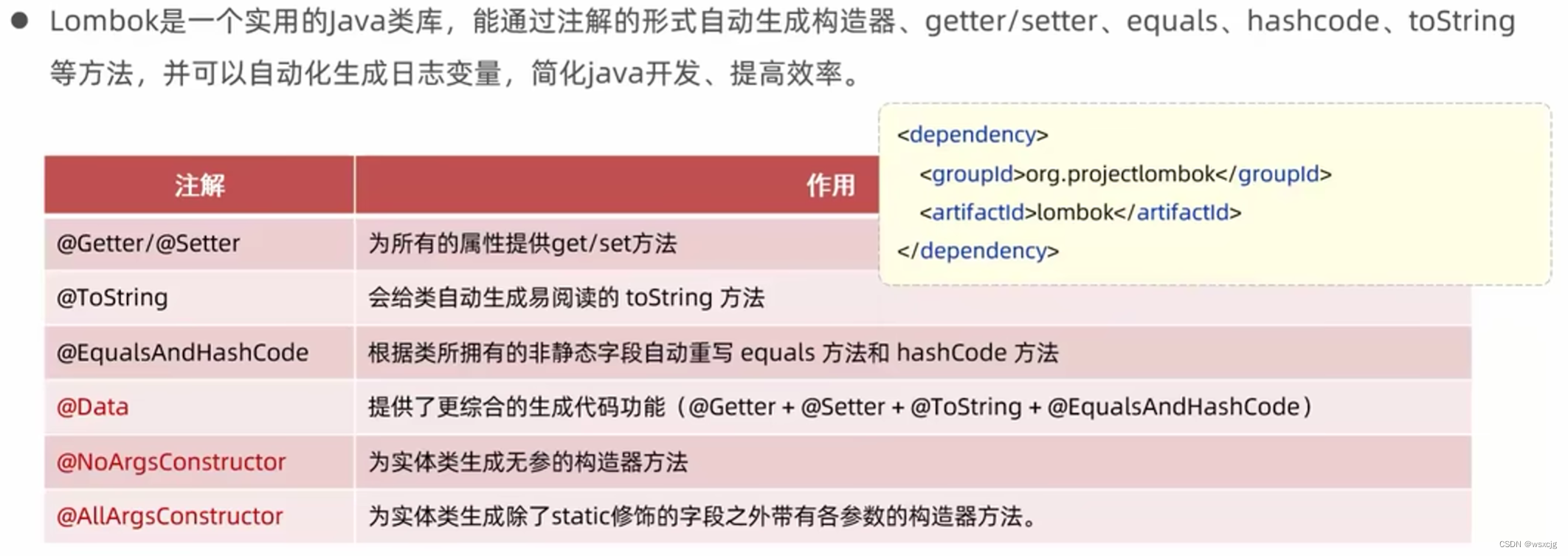
Mybatis日志:
在application.properties中添加代码
#配置Mybatis的日志信息,并输出到控制台
mybatis.configuration.log-impl=org.apache.ibatis.logging.stdout.StdOutImpl数据库操作
1.通过注解操作数据库
删除操作
根据主键删除:

代码演示:
Mapper类:
@Mapper
public interface EmpMapper {@Delete("delete from emp where id = #{id}")public void delete(Integer id);}单元测试:
@SpringBootTest
class SpringbootMybatisQuickstartApplicationTests {@Autowiredpublic EmpMapper empMapper;@Testpublic void deleteTest() {empMapper.delete(17);}}注意:
Mapper中的SQL语句“delete from emp where id = #{id}”,这里我们使用的#占位符,表示大括号中间的id为传递的参数,除了#占位符还有$占位符,但是它们有一些区别
★#占位符和$占位符的区别:
使用#占位符执行SQL时会将#{...}替换为?,生成预编译SQL,会自动设置参数值,使用时机:参数传递
使用$占位符执行SQL时会直接将参数拼接到SQL语句中,存在SQL注入问题.
SQL注入:
SQL注入就是通过操作输入的数据来修改事先定义好的SQL语句,以达到执行代码对服务器进行攻击的方法。
比如username='....' and password='.....',传递给password参数:' or '1' = '1 ,这样会得到username='....' and password='' or '1' = '1',总是为true,这样不知道用户名和密码也可以登录了,使用时机:对表名、列表进行动态设置时使用。
SQL预编译的好处:
1.性能更高:要想执行SQL语句,要连接上数据库,然后将SQL语句发送到数据库中,再进行SQL语法解析检查,优化SQL,编译SQL,执行SQL。但是在SQL语法解析检查,优化SQL,编译SQL过程中,为了提高效率,它会将优化编译后的SQL缓存起来,比如delete from emp where id = #{id},会缓存为delete from emp where id = ?,这样如果只有后面传递的id参数值改变,只需要在缓存中调用这一句即可,就只需要编译一次
2.更安全(防止SQL注入),通过参数赋值的方法不会更改原本的SQL语义
新增操作
新增:

代码演示:
Mapper类:
@Mapper
public interface EmpMapper {@Insert("insert into emp(username, name, gender, image, job, entrydate, dept_id, create_time, update_time)" +"values(#{username},#{name},#{gender},#{image},#{job},#{entrydate},#{deptId},#{createTime},#{updateTime})")public void insert(Emp emp);}单元测试:
@SpringBootTest
class SpringbootMybatisCrudApplicationTests {@Autowiredprivate EmpMapper empMapper;@Testvoid insertTest() {Emp emp = new Emp();emp.setUsername("han");emp.setName("韩");emp.setGender((short) 1);emp.setJob((short) 1);emp.setEntrydate(LocalDate.of(2010,1,1));emp.setDeptId(1);emp.setCreateTime(LocalDateTime.now());emp.setUpdateTime(LocalDateTime.now());empMapper.insert(emp);}}新增(主键返回):

代码演示:
@Mapper
public interface EmpMapper {@Options(useGeneratedKeys = true,keyProperty = "id")@Insert("insert into emp(username, name, gender, image, job, entrydate, dept_id, create_time, update_time)" +"values(#{username},#{name},#{gender},#{image},#{job},#{entrydate},#{deptId},#{createTime},#{updateTime})")public void insert(Emp emp);}更新操作:
更新:

代码演示:
Mapper:
@Mapper
public interface EmpMapper {@Update("update emp set username= #{username},name= #{name},gender= #{gender},image= #{image}," +"job= #{job},entrydate= #{entrydate},dept_id= #{deptId},update_time = #{updateTime} where id = #{id}")public void update(Emp emp);
}单元测试:
@SpringBootTest
class SpringbootMybatisCrudApplicationTests {@Autowiredprivate EmpMapper empMapper;@Testvoid updateTest() {Emp emp = new Emp();emp.setId(19);emp.setUsername("han1");emp.setName("韩1");emp.setImage("1.jpg");emp.setGender((short) 1);emp.setJob((short) 1);emp.setEntrydate(LocalDate.of(2010,1,1));emp.setDeptId(1);emp.setUpdateTime(LocalDateTime.now());empMapper.update(emp);}}查询操作:
根据id查询:
代码演示:
Mapper:
@Mapper
public interface EmpMapper {@Select("select * from emp where id = #{id}")public Emp getById(Integer id);
}
单元测试:
@SpringBootTest
class SpringbootMybatisCrudApplicationTests {@Autowiredprivate EmpMapper empMapper;@Testvoid getByIdTest() {Emp emp = empMapper.getById(19);System.out.println(emp);}}注意:
这种编写方式得到的结果中有一部分属性值为null

这是因为mybatis的数据封装特性(如下)。
数据封装:

解决方案一:
给字段起别名,让别名与实体类属性保持一致
代码演示:
Mapper:
@Mapper
public interface EmpMapper {/*//与属性名不一致的字段会赋值为null@Select("select * from emp where id = #{id}")public Emp getById(Integer id);*///解决方案一:给字段起别名,让别名与实体类属性保持一致@Select("select id, username, password, name, gender, image, job, entrydate, " +"dept_id deptId, create_time createTime, update_time updateTime" +" from emp where id = #{id}")public Emp getById(Integer id);}
解决方案二:
通过@Results,@Result注解手动映射封装
代码演示:
Mapper:
@Mapper
public interface EmpMapper {/*//与属性名不一致的字段会赋值为null@Select("select * from emp where id = #{id}")public Emp getById(Integer id);*//*//解决方案一:给字段起别名,让别名与实体类属性保持一致@Select("select id, username, password, name, gender, image, job, entrydate, " +"dept_id deptId, create_time createTime, update_time updateTime" +" from emp where id = #{id}")public Emp getById(Integer id);*///解决方案二:通过@Results,@Result注解手动映射封装@Results({@Result(column = "dept_id",property = "deptId"),@Result(column = "create_time",property = "createTime"),@Result(column = "update_time",property = "updateTime")})@Select("select * from emp where id = #{id}")public Emp getById(Integer id);}解决方案三(推荐):
开启mybatis的驼峰命名自动映射开关
操作步骤:
只需要在mybatis配置文件application.properties中添加代码
#开启mybatis的驼峰命名自动映射开关(camel)
mybatis.configuration.map-underscore-to-camel-case=true这样就可以使用最初的代码也能正确赋值
但是需要注意:数据库中的字段名要采用下划线命名,Java类中的属性名要采用驼峰命名法
条件查询:
根据姓名(模糊匹配)、性别、入职日期范围,来查找员工
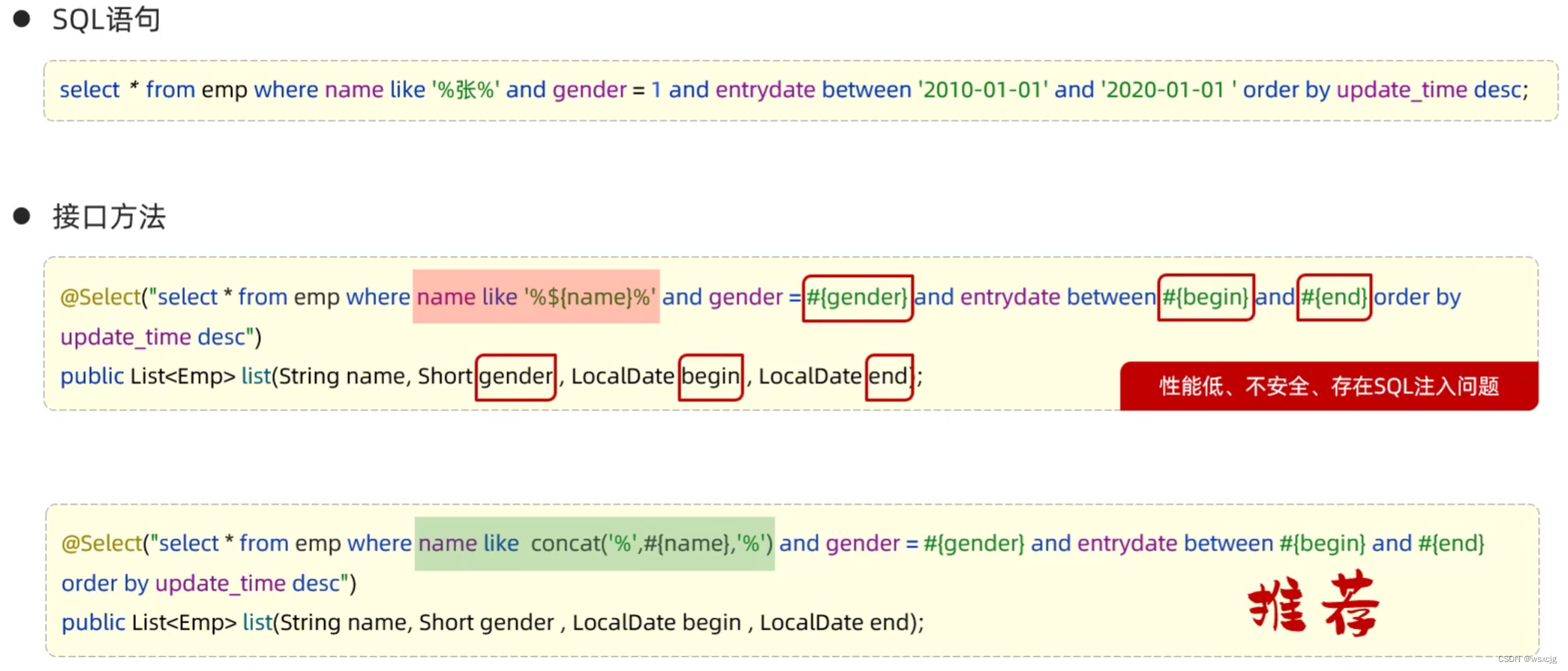
代码演示:
Mapper:
@Mapper
public interface EmpMapper {//条件查询@Select("select * from emp where name like concat('%',#{name},'%') and gender = #{gender} and " +"entrydate between #{begin} and #{end} order by update_time DESC")public List<Emp> getList(String name, short gender, LocalDate begin, LocalDate end);}这里使用concat函数,是由于#{}会生成预编译SQL,编译后会转换成?,而?存在于单引号中会被认为是字符串,所以使用concat函数,来进行字符串的拼接。
单元测试:
@SpringBootTest
class SpringbootMybatisCrudApplicationTests {@Autowiredprivate EmpMapper empMapper;@Testvoid listTest() {List<Emp> list = empMapper.getList("张", (short) 1, LocalDate.of(2010, 1, 1), LocalDate.of(2020, 1, 1));System.out.println(list);}}2.通过XML映射文件操作数据库:
除了可以使用注解来操作数据库,还可以使用XML映射文件。

代码演示:
xml文件:
<?xml version="1.0" encoding="UTF-8" ?>
<!DOCTYPE mapperPUBLIC "-//mybatis.org//DTD Mapper 3.0//EN""http://mybatis.org/dtd/mybatis-3-mapper.dtd">
<!--上面为依赖部分,可在Mybatis中文网->入门 中的SQL部分截取-->
<mapper namespace="com.han.mapper.EmpMapper"><!--resultType:单条记录所封装的类型--><select id="getList" resultType="com.han.pojo.Emp">select * from emp where name like concat('%',#{name},'%') and gender = #{gender} andentrydate between #{begin} and #{end} order by update_time DESC</select></mapper>Mapper:
@Mapper
public interface EmpMapper {public List<Emp> getList(String name, short gender, LocalDate begin, LocalDate end);
}单元测试:
@SpringBootTest
class SpringbootMybatisCrudApplicationTests {@Autowiredprivate EmpMapper empMapper;@Testvoid listTest() {List<Emp> list = empMapper.getList("张", (short) 1, LocalDate.of(2010, 1, 1), LocalDate.of(2020, 1, 1));System.out.println(list);}}3.使用场景
使用Mybatis的注解,主要是来完成一些简单的增删改查功能/如果需要实现复杂的SQL功能,建议使用XML来配置映射语句。
动态SQL:

标签:
1.<if>(<where>、<set>)
查找(<where>):
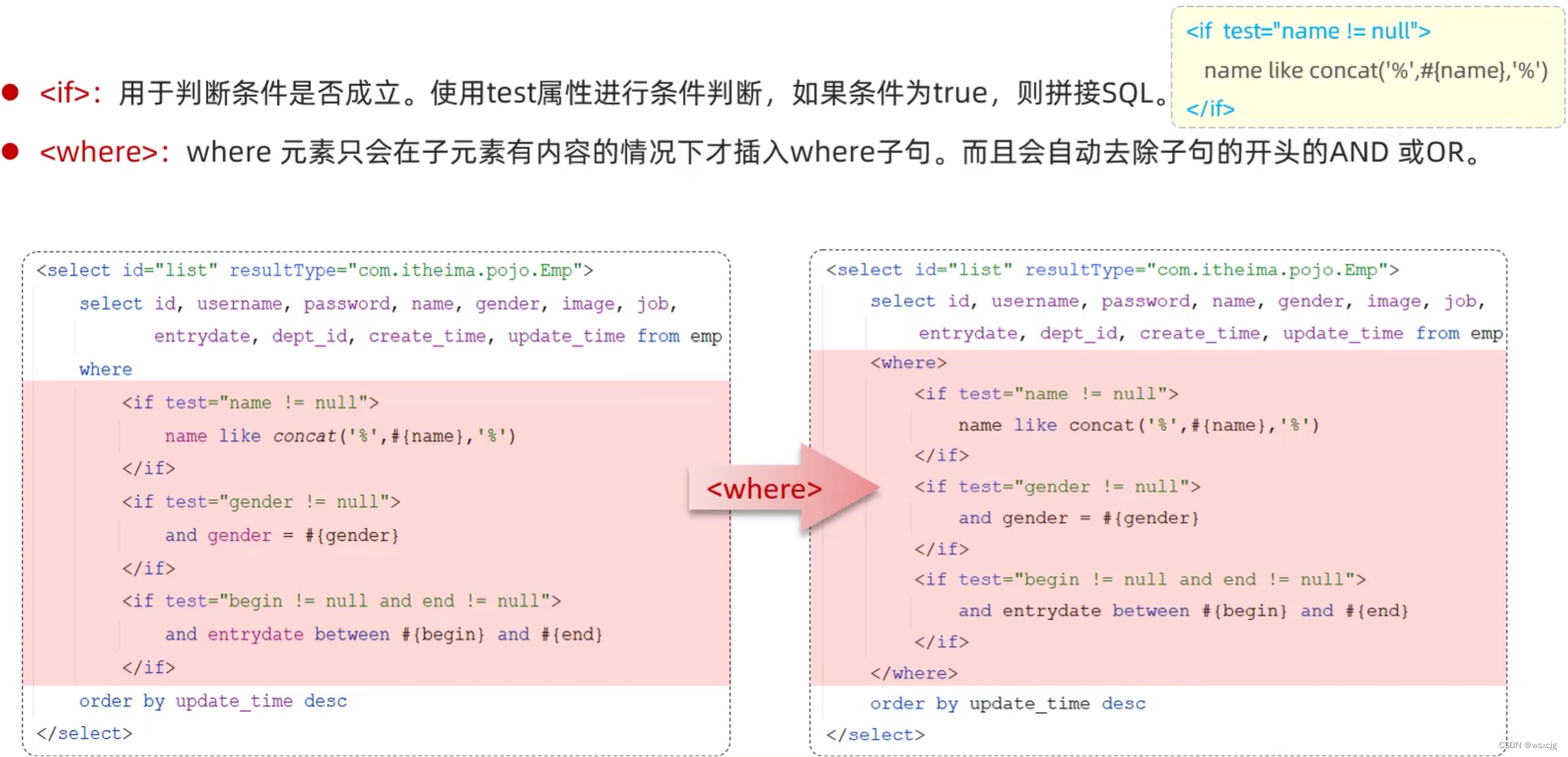
更新(<set>):
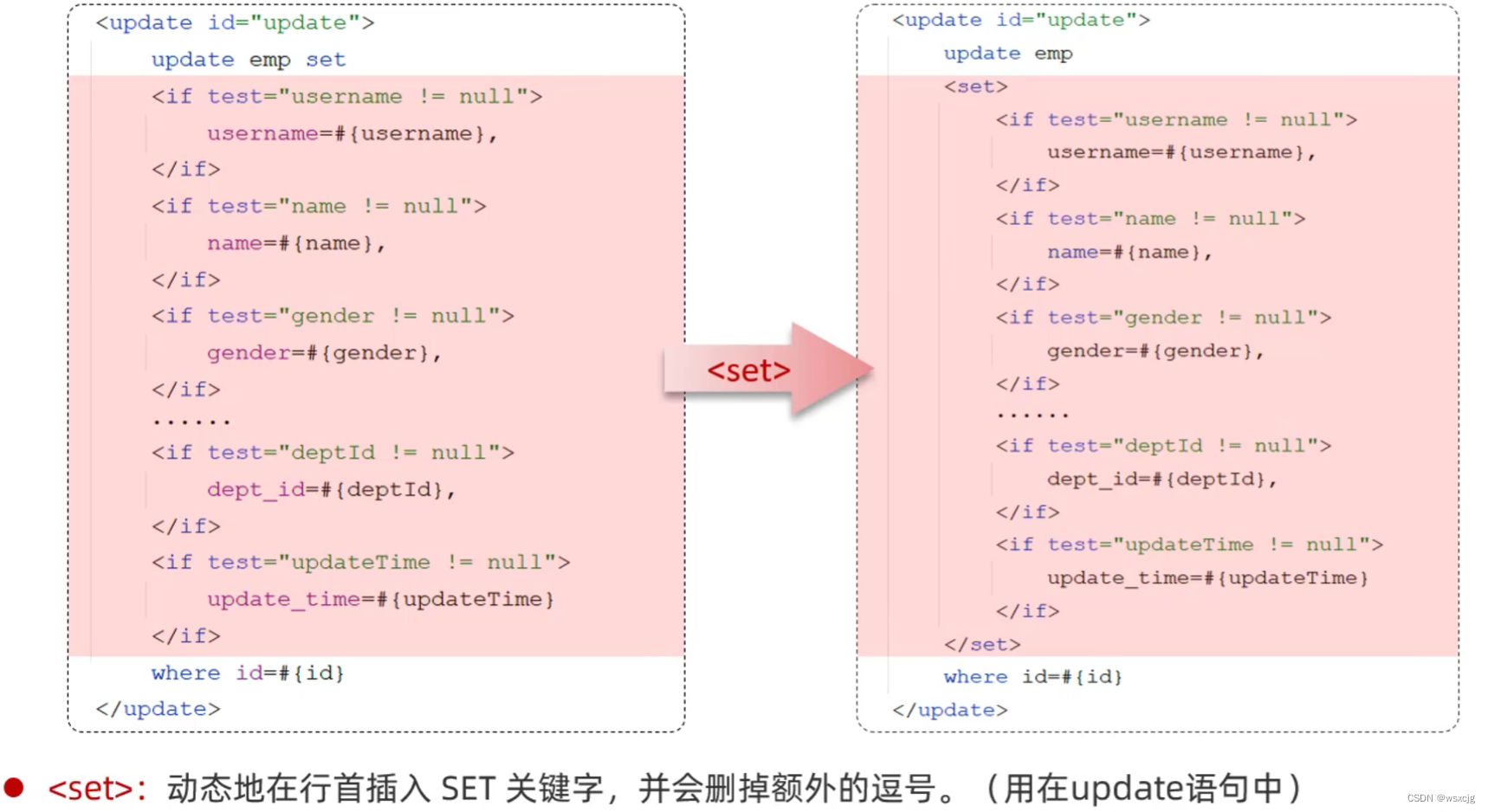
2.<foreach>
<foreach>一般用于批量操作。
批量操作:
代码演示(批量删除):
XML文件:
<?xml version="1.0" encoding="UTF-8" ?>
<!DOCTYPE mapperPUBLIC "-//mybatis.org//DTD Mapper 3.0//EN""http://mybatis.org/dtd/mybatis-3-mapper.dtd">
<!--上面为依赖部分,可在Mybatis中文网->入门 中的SQL部分截取-->
<mapper namespace="com.han.mapper.EmpMapper"><!--resultType:单条记录所封装的类型--><delete id="deleteByIds">delete from emp where id in /*(11,12,13)*/<foreach collection="ids" item="id" separator="," open="(" close=")">#{id}</foreach></delete></mapper>Mapper:
@Mapper
public interface EmpMapper {public void deleteByIds(List<Integer> ids);
}
单元测试:
@SpringBootTest
class SpringbootMybatisCrudApplicationTests {@Autowiredprivate EmpMapper empMapper;@Testvoid deleteByIdsTest() {List<Integer> list = Arrays.asList(11, 12, 13);empMapper.deleteByIds(list);}}3.<sql>&<include>

代码演示:
如下面的XML文件代码,其中有一段动态SQL条件查询代码和一段根据id查询代码,它们中有大段的复用代码,如:
select id, username, password, name, gender, image, job, entrydate, dept_id, create_time, update_time
from emp
使用前代码:
<?xml version="1.0" encoding="UTF-8" ?>
<!DOCTYPE mapperPUBLIC "-//mybatis.org//DTD Mapper 3.0//EN""http://mybatis.org/dtd/mybatis-3-mapper.dtd">
<!--上面为依赖部分,可在Mybatis中文网->入门 中的SQL部分截取-->
<mapper namespace="com.han.mapper.EmpMapper"><!--resultType:单条记录所封装的类型--><select id="getById" resultType="com.han.pojo.Emp">select id, username, password, name, gender, image, job, entrydate, dept_id, create_time, update_timefrom empwhere id = #{id}</select><!--resultType:单条记录所封装的类型--><select id="getList" resultType="com.han.pojo.Emp">select id, username, password, name, gender, image, job, entrydate, dept_id, create_time, update_timefrom emp<where><if test="name != null">name like concat('%', #{name}, '%')</if><if test="gender != null">and gender = #{gender}</if><if test="begin != null and end != null">and entrydate between #{begin} and #{end}</if></where>order by update_time DESC</select></mapper>使用<sql>和<include>可以减少代码复用
如下面代码
使用后代码:
<?xml version="1.0" encoding="UTF-8" ?>
<!DOCTYPE mapperPUBLIC "-//mybatis.org//DTD Mapper 3.0//EN""http://mybatis.org/dtd/mybatis-3-mapper.dtd">
<!--上面为依赖部分,可在Mybatis中文网->入门 中的SQL部分截取-->
<mapper namespace="com.han.mapper.EmpMapper"><sql id="commonSelect">select id, username, password, name, gender, image, job, entrydate, dept_id, create_time, update_timefrom emp</sql><!--resultType:单条记录所封装的类型--><select id="getById" resultType="com.han.pojo.Emp"><include refid="commonSelect"/>where id = #{id}</select><!--resultType:单条记录所封装的类型--><select id="getList" resultType="com.han.pojo.Emp"><include refid="commonSelect"/><where><if test="name != null">name like concat('%', #{name}, '%')</if><if test="gender != null">and gender = #{gender}</if><if test="begin != null and end != null">and entrydate between #{begin} and #{end}</if></where>order by update_time DESC</select></mapper>相关文章:

Java_Mybatis
Mybatis是一款优秀的持久层框架,用户简化JDBC(使用Java语言操作关系型数据库的一套API)开发 使用Mybatis查询所有用户数据: 代码演示: UserMapper: Mapper //被调用时会通过动态代理自动创建实体类,并放入IOC容器中…...
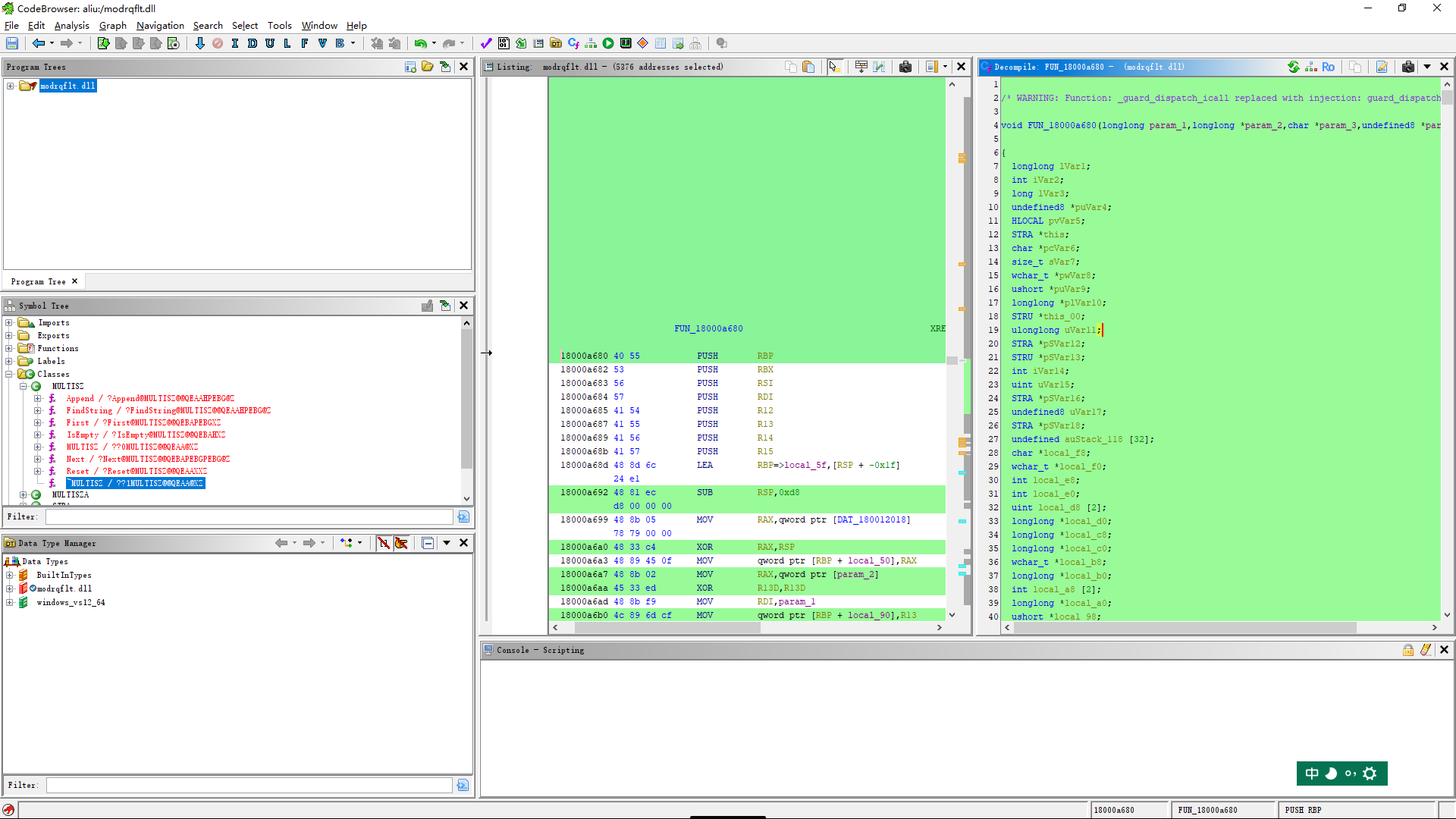
2024HW|常见红队使用工具
目录 什么是HW? 什么是网络安全红蓝对抗? 红队 常见工具 信息收集工具 Nmap 简介 漏洞扫描工具 Nessus简介 AWVS 简介 抓包工具 Wireshark简介 TangGo 简介 web 应用安全工具 Burpsuite 简介 SQLMap webshell 管理工具 蚁剑 冰蝎 后…...

Redisson集成SpringBoot
前言:Redisson集成SpringBoot主要有两种方式,一个是使用redisson-spring-boot-starter依赖(优先推荐),毕竟springboot主打的就是约定大于配置,这个依赖就是为springboot准备的。 再一种方式就是引入rediss…...
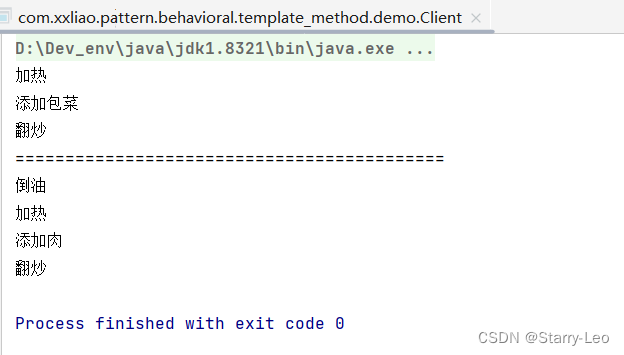
设计模式(十二)行为型模式---模板方法模式
文章目录 模板方法模式结构优缺点UML图具体实现UML图代码实现 模板方法模式 模板方法模式(Template Method)是一种基于继承实现的设计模式,主要思想是:将定义的算法抽象成一组步骤,在抽象类中定义算法的骨架ÿ…...

【气象常用】剖面图
效果图: 主要步骤: 1. 数据准备:我用的era5的散度数据(大家替换为自己的就好啦,era5数据下载方法可以看这里【数据下载】ERA5 各高度层月平均数据下载_era5月平均数据-CSDN博客) 2. 数据处理:…...

LabVIEW高低温试验箱控制系统
要实现LabVIEW高低温试验箱控制系统,需要进行硬件配置、软件设计和系统集成,确保LabVIEW能够有效地监控和控制试验箱的温度。以下是详细说明: 硬件配置 选择合适的试验箱: 确定高低温试验箱的型号和品牌。 确认试验箱是否支持外…...

Flutter 中的 SliverFillViewport 小部件:全面指南
Flutter 中的 SliverFillViewport 小部件:全面指南 Flutter 是一个由 Google 开发的跨平台 UI 框架,它允许开发者使用 Dart 语言来构建高性能、美观的移动、Web 和桌面应用。在 Flutter 的丰富组件库中,SliverFillViewport 是一个用于 Custo…...

明日周刊-第12期
以前小时候最期待六一儿童节了,父母总会给你满足一个愿望,也许是一件礼物也许是一次陪伴。然而这个世界上其实还有很多儿童过不上儿童节,比如某些地区的小孩子,他们更担心的是能不能见到明天的太阳。 文章目录 一周热点航天探索火…...

算法之美阅读笔记
这里写自定义目录标题 序04 缓存 -- 忘了它吧 序 在图书馆闲逛时,一本封面为绿色的清新的书引起了我的兴趣,书名是算法之美。我心里不禁嘀咕,大家好喜欢使用某某之美作为书名,比如:数学之美、架构之美。美丽美好的事物…...

新手学习STM32还是ESP32
对于新手来说,选择学习STM32还是ESP32取决于个人的学习目标和背景。以下是针对这两种微控制器的详细分析,以便您做出更明智的选择: STM32 1. 处理器架构与性能 STM32采用单核或多核处理器架构,基于ARM Cortex-M0,M0…...
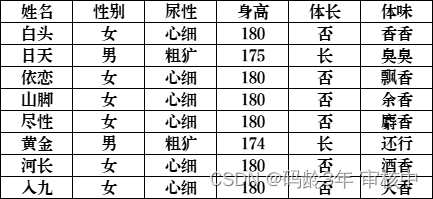
关于vlookup的第一个参数的个人理解
VLOOKUP(查阅值,包含查阅值和返回值的查找区域,查找区域中返回值的列号,精确查找或近似查找) 我个人理解,第一个参数应该叫线索值,因为我们要通过它去找与其对应的(也就是与其同行的…...

vector实现后半部分
一.迭代器失效 1.定义 指原迭代器在扩容/缩容/修改后指向无效元素或无效地址处 erase的迭代器失效 2.原因: 1.有的编译器实现erase会缩容拷贝 2.删除最后一个后,其指向无效元素 VS中不允许再次使用erase完的迭代器,为了让编写的代码移植…...
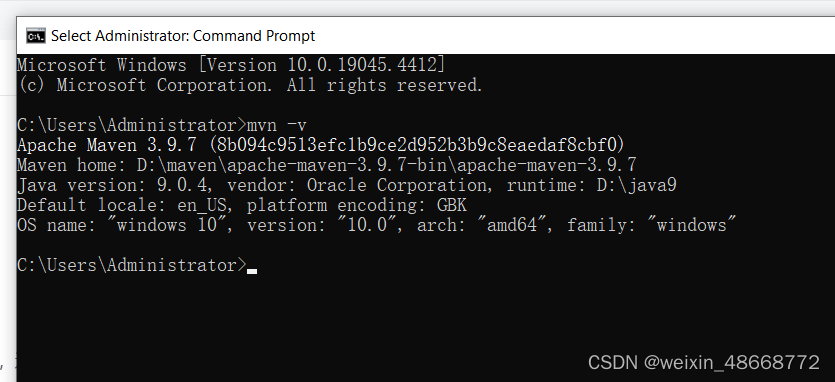
Maven配置
Maven – Download Apache Maven https://maven.apache.org/install.html 得下载有 bin的...

python 第一天
循环打印 while循环 languages ["Regional Assembly Language","Autocode","FORTRAN","IPL (LISP的先驱)","FLOW-MATIC (COBOL的先驱)","COMTRAN (COBOL的先驱)","LISP","ALGOL 58","F…...

Day03 左侧菜单数据绑定
一.左侧菜单数据绑定 1.首先,进行项目结构塔建。按照Prism 框架约定,要使用自动查找绑定功能。即View (视图)中自动查找并绑定到对应的ViewModel(视图模型,处理视图业务逻辑)。就需要在项目中按…...

JavaScript笔记三-JavaScript常用对象
1、数字对象(Number) 1.1 、属性 属性描述Number.MAX_VALUEJavaScript 中所能表示的最大值Number.MIN_VALUEJavaScript 中所能表示的最小值Number.NaN非数字Number.NEGATIVE_INFINITY负无穷,在溢出时返回Number.POSITIVE_INFINITY正无穷&am…...

最新的CleanMyMac X4.15.4中文破解版新功能介绍及CleanMyMac 安装激活指南
知名的Mac系统清理软件CleanMyMac发布了最新的CleanMyMac X4.15.4,更换了矩形图标,更好的融合和兼容macOS Snoma系统。新版CleanMyMac 支持Intel芯片和苹果M1/M2芯片的Mac。 优化 Mac 电脑,用 CleanMyMac X4.15.4中文版 就够了!强…...

密文域可逆信息隐藏安全性研究-从图像到视频
前言 随着云存储、云计算等新兴技术的兴起,海量的隐私信息被广泛地上传、存储到服务器上。为保证用户的隐私性,必须对用户的数据进行加密,然后再将其上传到服务器上。因此,密文域的可逆信息隐藏(reversible data hiding in encry…...

使用Python进行图像锐化的4个基础操作
想要让你的照片从模糊变锐利,就像魔法师轻轻一挥魔杖?今天我们就来学习如何用Python施加这神奇的“锐化滤镜”!🎉 首先,你需要一位得力助手——Pillow库,它能让我们轻松处理图像。如果你还没安装ÿ…...

图解 Python 编程(9) | 模块和包
🌞欢迎来到Python的世界 🌈博客主页:卿云阁 💌欢迎关注🎉点赞👍收藏⭐️留言📝 🌟本文由卿云阁原创! 📆首发时间:🌹2024年6月2日&…...

AI Agent与Agentic AI:原理、应用、挑战与未来展望
文章目录 一、引言二、AI Agent与Agentic AI的兴起2.1 技术契机与生态成熟2.2 Agent的定义与特征2.3 Agent的发展历程 三、AI Agent的核心技术栈解密3.1 感知模块代码示例:使用Python和OpenCV进行图像识别 3.2 认知与决策模块代码示例:使用OpenAI GPT-3进…...

DockerHub与私有镜像仓库在容器化中的应用与管理
哈喽,大家好,我是左手python! Docker Hub的应用与管理 Docker Hub的基本概念与使用方法 Docker Hub是Docker官方提供的一个公共镜像仓库,用户可以在其中找到各种操作系统、软件和应用的镜像。开发者可以通过Docker Hub轻松获取所…...

SCAU期末笔记 - 数据分析与数据挖掘题库解析
这门怎么题库答案不全啊日 来简单学一下子来 一、选择题(可多选) 将原始数据进行集成、变换、维度规约、数值规约是在以下哪个步骤的任务?(C) A. 频繁模式挖掘 B.分类和预测 C.数据预处理 D.数据流挖掘 A. 频繁模式挖掘:专注于发现数据中…...

全球首个30米分辨率湿地数据集(2000—2022)
数据简介 今天我们分享的数据是全球30米分辨率湿地数据集,包含8种湿地亚类,该数据以0.5X0.5的瓦片存储,我们整理了所有属于中国的瓦片名称与其对应省份,方便大家研究使用。 该数据集作为全球首个30米分辨率、覆盖2000–2022年时间…...

【ROS】Nav2源码之nav2_behavior_tree-行为树节点列表
1、行为树节点分类 在 Nav2(Navigation2)的行为树框架中,行为树节点插件按照功能分为 Action(动作节点)、Condition(条件节点)、Control(控制节点) 和 Decorator(装饰节点) 四类。 1.1 动作节点 Action 执行具体的机器人操作或任务,直接与硬件、传感器或外部系统…...

html-<abbr> 缩写或首字母缩略词
定义与作用 <abbr> 标签用于表示缩写或首字母缩略词,它可以帮助用户更好地理解缩写的含义,尤其是对于那些不熟悉该缩写的用户。 title 属性的内容提供了缩写的详细说明。当用户将鼠标悬停在缩写上时,会显示一个提示框。 示例&#x…...

IP如何挑?2025年海外专线IP如何购买?
你花了时间和预算买了IP,结果IP质量不佳,项目效率低下不说,还可能带来莫名的网络问题,是不是太闹心了?尤其是在面对海外专线IP时,到底怎么才能买到适合自己的呢?所以,挑IP绝对是个技…...

Bean 作用域有哪些?如何答出技术深度?
导语: Spring 面试绕不开 Bean 的作用域问题,这是面试官考察候选人对 Spring 框架理解深度的常见方式。本文将围绕“Spring 中的 Bean 作用域”展开,结合典型面试题及实战场景,帮你厘清重点,打破模板式回答,…...

如何配置一个sql server使得其它用户可以通过excel odbc获取数据
要让其他用户通过 Excel 使用 ODBC 连接到 SQL Server 获取数据,你需要完成以下配置步骤: ✅ 一、在 SQL Server 端配置(服务器设置) 1. 启用 TCP/IP 协议 打开 “SQL Server 配置管理器”。导航到:SQL Server 网络配…...

相关类相关的可视化图像总结
目录 一、散点图 二、气泡图 三、相关图 四、热力图 五、二维密度图 六、多模态二维密度图 七、雷达图 八、桑基图 九、总结 一、散点图 特点 通过点的位置展示两个连续变量之间的关系,可直观判断线性相关、非线性相关或无相关关系,点的分布密…...

